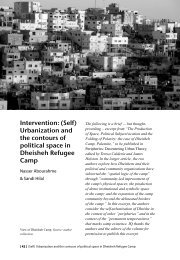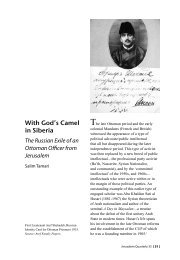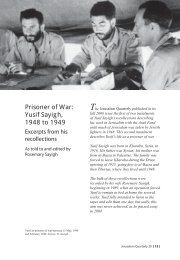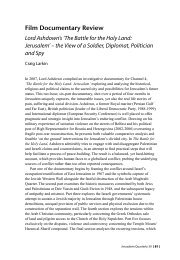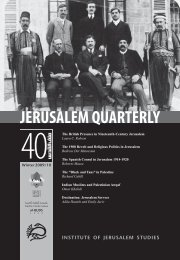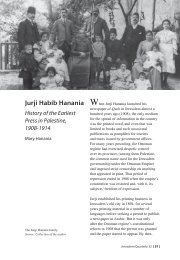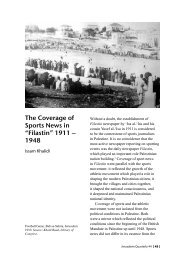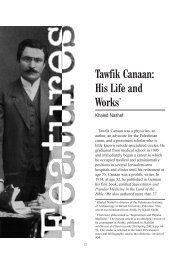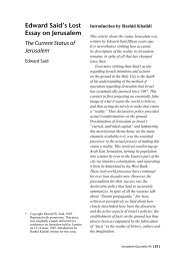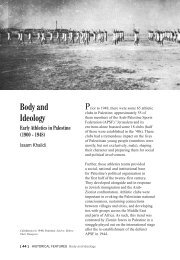PLUNDERING PALESTINE - Jerusalem Quarterly
PLUNDERING PALESTINE - Jerusalem Quarterly
PLUNDERING PALESTINE - Jerusalem Quarterly
Create successful ePaper yourself
Turn your PDF publications into a flip-book with our unique Google optimized e-Paper software.
a truly commercial run of the volume would surely elicit a response one level higher<br />
(or lower) than this forcibly limited edition. There would be a political uproar among<br />
those Palestinian refugees living in the region or around the world, who have always<br />
known of the fate of their own villages, houses and mosques. And there would be<br />
an uproar within the scholarly community, because the ideological presuppositions,<br />
the methodological inadequacies and the political intent of the volume deconstruct<br />
themselves almost too readily, and thus command refutation.<br />
And indeed, the author is conscious of this conundrum. He talks about the first<br />
generation of Israeli archaeologists working in the decade following the creation of<br />
the state. An employee of the Israel Antiquities Authority, he owes his superiors and<br />
the censor, who gave him clearance to publish a book that is nonetheless based, we are<br />
told, on materials readily available to the public. And the subject matter he is treating<br />
stops half a century ago, so as further to minimize risk-taking, since the details he<br />
uncovers relate to facts that are known and were readily bandied around by those who<br />
perpetrated them like Moshe Dayan (“there is not a single [Jewish] settlement that was<br />
not established in the place of a former Arab village”). The book is intended to assert<br />
the primacy of pristine British archaeological ethics and the adherence of the Israeli<br />
profession to them, by and large. The value system that looks up to and identifies<br />
with the model of the former colonial master for guidance is characteristic of a certain<br />
post-independence national intelligentsia, particularly in the Israeli case where the<br />
colonized people are still there, underfoot. One wonders if he has considered British<br />
archaeology’s behaviour and values (viz. Lord Elgin and the Erechtheion’s stolen<br />
caryatid, or Howard Carter, who cut poor King Tut Ankh Amon into eighteen pieces<br />
after 3,000 years in order to get all the jewellery). But the details don’t seem to<br />
interest him; he is entranced with the symbol of the elevated, emphatically European<br />
and most emphatically not Middle Eastern value system of the Israeli antiquities and<br />
archaeological elite.<br />
Nonetheless, and beneath the somewhat tedious and lengthy quotations, there appear<br />
some interesting data, making this a primary source of sorts. There are documents<br />
relating to the Palestine Archaeological (“Rockefeller”) Museum (whose status is to<br />
be determined along with the rest of final status issues, which is a bit disconcerting<br />
considering the fact that the identical Palestinian team that brought us Oslo is back<br />
at work), and one infers something about the contradictions between the preservation<br />
of antiquities (which under British-based Israeli law include buildings erected<br />
before 1700) and urban restoration or development, which should have but did not<br />
seek to preserve viable habitat. But the overriding intention is to clear the Israeli<br />
archaeological profession of charges that they participated wholeheartedly, or even<br />
in any significant way, in the frenzy of destruction of Palestinian private, public and<br />
holy structures that began around 1948. Carefully, the author limits the period under<br />
review to the 1950s (a couple of years before, a couple after), and prudently stops well<br />
[ 72 ] REVIEWS Whitewashing: ‘Everybody’ Does It



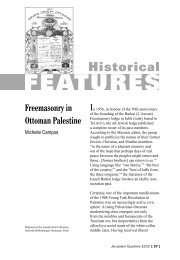
![In Search of Jerusalem Airport [pdf] - Jerusalem Quarterly](https://img.yumpu.com/49007736/1/180x260/in-search-of-jerusalem-airport-pdf-jerusalem-quarterly.jpg?quality=85)
